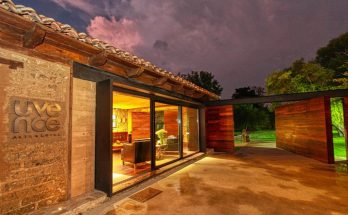Table of Contents

Tulum Ruins
Tulum Ruins may not have the largest and most impressive set of Mayan buildings in the Yucatan but its location, on a 40 foot precipice looking out over the aquamarine Caribbean Sea toward the sunrise, is easily the most spectacular. Below the cliffs, with access from inside the ruins,
is a small beach that can be used by people who visit the ruins. Originating as a port city, probably called Zama (‘City of Dawn’ in Mayan), and the Mayans last stronghold against the Spanish colonialists, Tulum now attracts over two million visitors a year.

Entry to the site costs $80 Pesos (4 USD) and you can hire an official guide, available in many languages, for varying prices: these prices start at $540 Pesos for two people (40USD) and decrease as the group size gets larger.
These guides are not necessary, as there are placards around the site, in English and Spanish, detailing the different buildings and their suspected uses; but the guides contain a wealth of information on Mayan culture and history to bring the ruins to life around you!
There is also the option of downloading the Tulum self guide App. It is written and read by renowned archaeologist Dr. Edwin Barnhart, and contains details on almost every notable stone on the Tulum site. This guide costs only 1USD; however it’s focus lies in the architecture of, and artwork on, the buildings; and doesn’t tell you nearly as much about the Mayan culture as one of the tour guides will. To our knowledge this is only available on Apple devices.

The recommendation is to get there early (the site is open from 8am until 5pm) not only to avoid walking around under the blazing sun in the height of the day, but also to avoid the tour groups that arrive in their droves from around 9:30am/10am.
Known as the City of Dawn for good reasons, you could even get down there for sunrise on the beach that lies just down the coast. To do this go to the entrance of the site but instead of turning left to enter the site follow the road round to the right and continue down it (for about 750 meters) until you reach the entrance to the beach on your left. This means you can be also be at the gate for when it opens and, almost, have the place to yourself.
About the Ruins
Unfortunately you are not allowed to enter or climb any of the ruins in Tulum as you are in some other sites; but the architecture in this oceanside setting are still to be admired. Tulum is the Maya word for “wall”, so it’s no surprise to find that the site is surrounded by 16ft walls on the three sides that don’t face the ocean. There are four buildings to note on the Tulum site: the Castillo, the Temple of the Wind God, the Cenote House and the Temple of Frescos.

The Castillo
The Castillo is the building that stands at the head of the city, towering over the rest of the city from its cliff-side vantage point. Like all Mayan buildings it was built in stages, and is one building constructed on top of another.
This is a temple to the Gods and, although many of the carving and remains of paintings are on the inside, carving of can be seen above the entrance at the top of the steps. When accessing the site from the ocean there is only one safe passage through the reefs that can be taken.

On the east (sea) facing wall of the temple are two windows. For boats to arrive by night two lighted candles were placed in these windows and when the boat was positioned so it could see the light from both candles its passage was true and it could pass safely through the reef. Another defense to add to list of this heavily fortified site.
The Temple of the Wind God
This lies on the cliff edge near the north wall and before its door lies a group of tiny shrines. It is given the title of the Temple of the Wind God because of its circular platform. This is unique in Tulum the site and very rare in the Yucatán itself.
This is said to be taken from Aztec architecture, as their temples to the Wind God all have circular bases. With the site chosen because of its windy location on the edge of the cliffs, this building was probably erected after 1400AD once a trade bond with the Aztecs had been established.

The Cenote House
Located directly next to the Northeast entrance to the site this building was named so because it is built directly over a cenote; probably Tulum’s only source of fresh water. Although you cannot go inside the building there is a path leads down and round to the entrance of the cenote. There used to be a set of steps that would have led from the house down to this entrance.

The Temple of the Frescos
Like most Mayan buildings the Temple of the Frescos was built in stages. The lower and original structure, which, unusually, was left unsealed, contains one of the earliest depictions of the Diving God on site. There is still some trace of blue green frescoes (mural paintings) on the exterior walls, which shed some light on how colourful these buildings may have looked back when this city was in its prime. There are more, better kept, frescos inside; but unfortunately tourists are not allowed inside.
There is much more to be seen here than these few sights and touring the whole place will probably take you around two hours. With these facts, and any more of your own research at hand, walk through the city and imagine it comes to life around you! This is one of the easiest accessible ruins on the Riviera Maya, and easily one of the most picturesque.

Conclusion
Visiting Tulum, will undoubtedly be a real adventure that will make us get lost among its nature composed of beaches, cenotes, caverns, tropical jungles, among its archaeological sites, without forgetting Coba and among a large number of hotels and by the way, you may be interested in reading about: Best cenotes in Tulum, Best cheap hotels in Tulum, Hotels in Tulum Mexico All Inclusive and Best Beachfront Hotels in Tulum.
Do you need to go to Tulum? Meet Transfers Plus, a transfer agency that offers the best transfer to Tulum.




